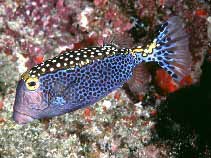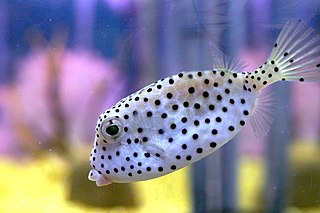Monte Bolca is a lagerstätte near Verona, Italy that was one of the first fossil sites with high quality preservation known to Europeans, and is still an important source of fossils from the Eocene.

The longhorn cowfish, also called the horned boxfish, is a species of boxfish from the family Ostraciidae, recognizable by its long horns that protrude from the front of its head, rather like those of a cow or bull. They are a resident of the Indo-Pacific region and can grow up to 50 cm (20 in) long.

The Mercedes-Benz Bionic is a concept car created by DaimlerChrysler AG under the Mercedes Group. It was first introduced in 2005 at the DaimlerChrysler Innovation Symposium in Washington, D. C. The Bionic is modeled after a type of fish, the yellow boxfish, Ostracion cubicus, and also has 80% lower nitrogen oxide emissions with its selective catalytic reduction technology.
Nasus coming from Nasus Externus in Latin meaning nostril, is the designated term for nose on fishes.

Ostracion is a genus of the boxfish family Ostraciidae. Fish in the genus are known as box puffers. It was first described by Carl Linnaeus in 1758 and makes a brief appearance in Jules Verne's maritime sci-fi novel Twenty Thousand Leagues Under The Sea.

The yellow boxfish is a species of boxfish found in reefs throughout the Pacific Ocean and Indian Ocean as well as the southeastern Atlantic Ocean. Recorded occasionally since 2011 in the Levantine waters of the Mediterranean Sea which it likely entered via the Suez Canal, it is a species appreciated in the aquarium trade.
Pahutoxin, formerly called ostracitoxin, is a neurotoxin present in the mucous secretions of boxfish (Ostraciidae) skin, while under stress. It is an ichthyotoxic, hemolytic, nonpeptide toxin. It is heat-stable and non-dialyzable, that is, foamed in aqueous solutions, and is toxic to various biological systems. It is unique among known fish poisons. It is toxic to other boxfish as well and looks like red tide and sea cucumber toxins in general properties. Although it is not recommended, it is a growing trend to keep boxfish in a home aquarium. Members of the family Ostraciidae secrete an ichthyotoxic mucus from their skin when stressed or disturbed.
Although most species in the Red Sea pose no threat to humans, there are a few notable exceptions.

The red-eye wrasse is a species of wrasse native to Indonesia and Australia, where found near the Lesser Sundas, Maluka and Darwin. It inhabits coral reefs on coastal and outer reef lagoons at depths of 5 to 35 m.

Spinacanthus cuneiformis is an extinct prehistoric tetraodontid bony fish that lived from the Lutetian epoch of Eocene Monte Bolca.

Eolactoria sorbinii is an extinct prehistoric boxfish that lived during the Lutetian epoch of the middle Eocene, in Monte Bolca. It had two pairs of long spines, one over each eye, and one pair beneath the anal and caudal fins, arranged very similarly to those possessed by the modern genus Lactoria, but were, in comparison, much longer. E. sorbinii had a fifth spine between the two eye-spines, arranged and looking very much like a nose.
In the 10th edition of Systema Naturae, Carl Linnaeus described the Pisces as:
Always inhabiting the waters; are swift in their motion and voracious in their appetites. They breathe by means of gills, which are generally united by a bony arch; swim by means of radiate fins, and are mostly covered over with cartilaginous scales. Besides the parts they have in common with other animals, they are furnished with a nictitant membrane, and most of them with a swim-bladder, by the contraction or dilatation of which, they can raise or sink themselves in their element at pleasure.

Protobalistum imperiale is an extinct prehistoric tetraodontid bony fish that lived from the Lutetian epoch of Eocene Monte Bolca.

The spotted or white-spottedboxfish, is a species of boxfish found in the Indian and Pacific Oceans. It is found on reefs at depths of from 1 to 30 metres. This species grows to a length of 25 centimetres. Males and females differ in colour: males are blackish on the back with white spots, and have bluish sides with bright yellowish bands and spots. Females and juveniles are dark brown to blackish with white spots. As with other species of boxfish, the spotted boxfish's bony carapace gives it a distinctly angular appearance; it has been described as resembling an ottoman.
Helcogramma solorensis, known commonly as the Solor triplefin, is a species of triplefin blenny in the genus Helcogramma. It was described by Fricke in 1997. It is endemic to Solor in East Nusa Tenggara, Indonesia.

Caprichthys gymnura, also known as the rigid boxfish, is a species of deepwater boxfish native to the waters of the continental shelf off the western and southern coasts of Australia. It is found at depths from 40 to 200 meters. This species grows to a length of 11 centimeters TL. This species is the only known member of the genus Caprichthys.

Ostracion rhinorhynchos is a species of boxfish commonly known as the horn-nosed boxfish or trunkfish. It was first described by Pieter Bleeker in 1851. It is found in the Indo-West Pacific, where it inhabits coral reefs and eats benthic invertebrates.

Aracana aurita, striped cowfish, Shaw's cowfish, striped boxfish, painted boxfish, southern cowfish or Shaw's boxfish is a species of boxfish native to the Eastern Indian Ocean. The species was first described by George Shaw in 1798. It is carnivorous and exposes prey in the benthic zone by blowing a jet of water onto sediment.

Ostracion nasus also known as the Shortnose boxfish is a species of boxfish found in the Indian and Pacific Oceans. This species grows to a length of 30 centimetres (12 in) TL.

Anoplocapros lenticularis, the white-barred boxfish, is a species of deepwater boxfish found in Australia.















